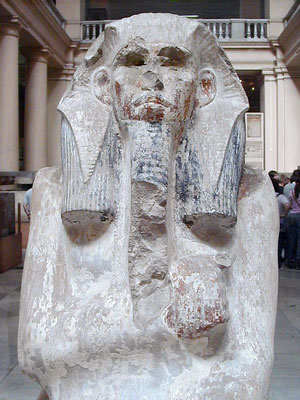
Fact File: The Step Pyramid
Height: 60m
Built for: Djoser (known as Netjerikhet in his own time)
Date: about 2650BC
Width of the edges: 121X109m
Volume: 330,400 cubic metres
Made of: limestone and clay
Diagram of the Step Pyramid, showing stages of construction and chambers underneath
The Step Pyramid
The Step Pyramid is the first of all the pyramids. It was built for King Djoser in around 2650BC - about 100 years before the Great Pyramid. It was built at Saqqara, about 7km south of Giza, and has 6 steps, each about 10m high. It is surrounded by an enormous enclosure wall,1645m long and 10m high. Inside is a complex of chapels and other buildings, as well as numerous tunnels and chambers underneath the pyramid and one of the chapels.
Djoser's construction was a hugely important moment in world history. Not only did he build the first pyramid, the whole enclosure marks the true beginning of stone architecture - large scale building in stone. Many of the designs seem to be based on the original materials used in the king's palace, such as wooden beams and columns (see photo right).
The complex was designed by Djoser's architect and high priest of Ra, Imhotep. Much later, Imhotep was worshipped as a god. His technical achievements here were amazing. As well as that, an astounding number of workers had to be organised, fed and housed. All of this shows us that ancient Egypt at this time was the most advanced civilization in the world.


Djoser
King Djoser was the second pharaoh of the 3rd dynasty, and lived about 4,600 years ago. He ruled for 19 years, although some experts think it was much longer, given all his building projects.
Djoser means 'holy'. In fact his real name was Netjerikhet, which means 'body of the gods'. This is the only name found written in the pyramid complex. It was later Egyptians, from the New Kingdom (the time of Tutankhamun and Rameses), who called him Djoser.

Next to the Step Pyramid was a stone box, called a serdab. Inside a stone statue of Djoser was found with crystal eyes, making them lifelike. The statue is now in the Cairo Museum, but there is a copy at Saqqara.


Imhotep, Djoser's vizier, doctor and architect
Diagram of the Step Pyramid and Enclosure (click for larger version)
How the Step Pyramid was Built
Before Djoser, pharaohs were buried in tombs called mastabas, which is the Arabic word for bench - because their shape is similar to that of a bench. The photo below is a mastaba of two noblemen. The burial chamber was dug out of the rock below the mastaba.

Djoser decided to have his mastaba enlarged, and then at some point he made a decision which changed Egypt forever - he wanted his mastaba to be taller.
Because the Egyptians didn't have strong modern materials like steel and concrete, they couldn't build the tomb straight up, or it would have collapsed. To go higher, the architect, Imhotep, built another, smaller mastaba on top. On top of that was another smaller mastaba - and so on, for six levels in all.
The photo below shows how the Step Pyramid has older structures inside the final large pyramid.


The faience tiles under the pyramid

The Enclosure

The Step
Pyramid is surrounded by a 1645m long wall with one entrance. The wall
itself is amazing - it was carved with niches 9m high all the way around, a
huge amount of work.
Inside the wall, as well as the pyramid, are lots of small structures - chapels, shrines, columns, stairways, and platforms. Many of these are not true buildings - they are solid, with no rooms inside. These were for the king's ka - his life force, a sort of spirit. The true buildings were used for religious ceremonies like the funeral.
The Underground Chambers
Under the pyramid and the Southern Chapel were maze-like systems of passages and rooms. Nothing as complex as this had ever been built before - there are a total of 5.7km of tunnels in all. A huge shaft (7m square and 28m deep) under the pyramid leads to the burial chamber, lined with granite. Sadly this was robbed thousands of years ago.
Plan of the passages under the Step Pyramid
On the walls of some of the passages under the pyramid are carvings showing the king (see below). There are also beautiful panels with curved blue tiles, representing the reed mats in the palace, as well as the water in the afterlife (see left).

The Step Pyramid enclosure from the air





